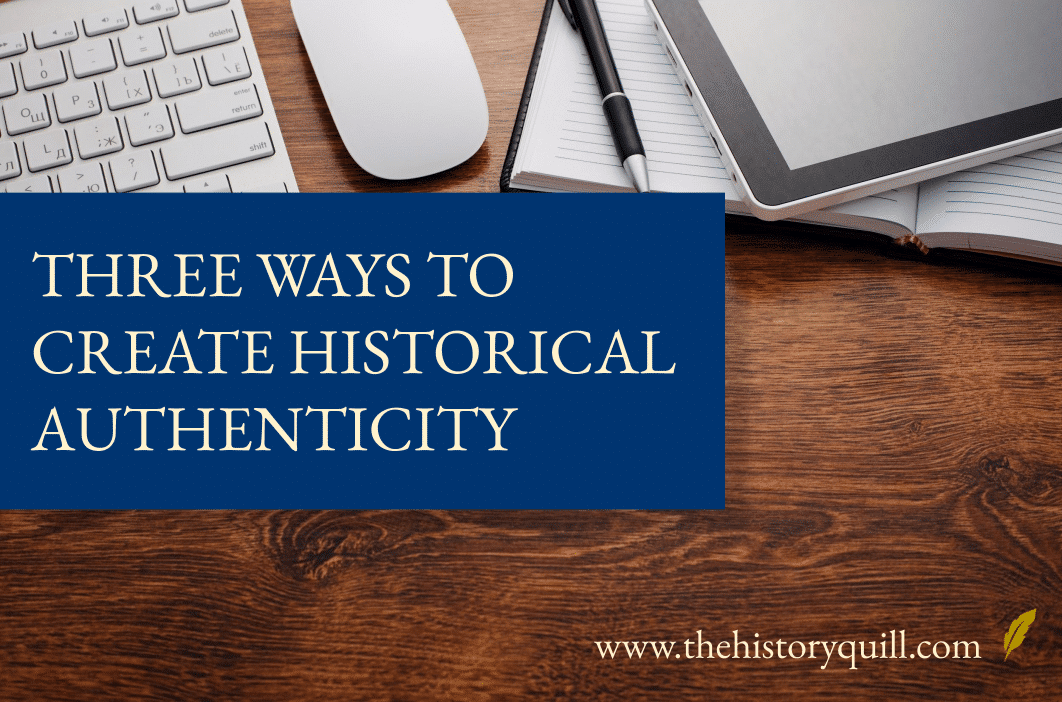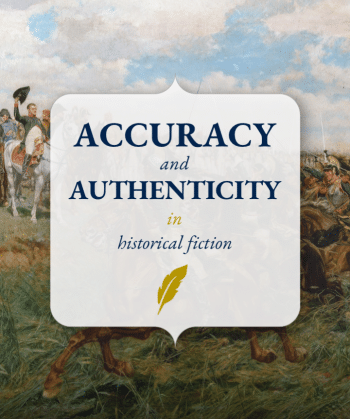Three ways to create historical authenticity
by Andrew Noakes

Authenticity is a crucial ingredient in historical fiction. Historical fiction readers want to be transported into a fictional world that feels true to its historical setting, and authenticity is what makes that possible. Now, authenticity and accuracy aren’t always the same thing, as we’ll see below, but the former is vital for making the reader feel like they’ve stepped back in time.
So how do we ensure authenticity in historical fiction? Below I’ve outlined three of the most important ways. You can also get our full guide on historical accuracy and authenticity, which includes advice on how to balance accuracy with creative license, tips on how to use effective research to avoid historical howlers, and a 3 step plan for achieving historical authenticity.
Accuracy and authenticity in historical fiction

1) Using authentic dialogue
Aleyn spak first, “Al hayl, Symond, y-fayth;
How fares thy faire doghter and thy wyf?”
“Aleyn! welcome,” quod Symond, “by my lyf,
And John also, how now, what do ye heer?”
This is how people spoke to each other in the late 14th century – well, they probably wouldn’t have used poetic meter and rhyme, but you get the point. These lines of dialogue come from The Canterbury Tales, written by Geoffrey Chaucer, and they give a good flavour of Middle English. If you want your 14th century dialogue to be historically accurate, this is what it’s going to have to look like.
Obviously, you’re not going to do that. Not any more than you’d write lines spoken by Julius Caesar in Latin. It would be accurate, but it would alienate the reader far more than it would impress them.
Authentic dialogue is a critical ingredient for grounding your story in its historical setting, but if you can’t always make it strictly accurate, how do you make it authentic? The trick is to make your dialogue feel like it could be at home in a historical setting while being perfectly accessible to the modern reader. Here’s an adapted version of the same lines from The Canterbury Tales:
Aleyn spoke first. “Good day, Symond. How’s your fine daughter and your wife?”
“Aleyn, welcome!” replied Symond. “And, by God, it’s John as well. Are you both well? What brings you here?”
These lines are much easier to understand than the original version. That means we’ve done our job well. But take a closer look and you’ll also see the nods to historical authenticity. First, we kept the original names (readers can usually cope with archaic names as long as they’re not hard to pronounce). Then we used a couple of phrases that might seem a little old-fashioned in contemporary speech, notably “Good day” and “by God”, while avoiding modern colloquialisms. At the same time, we used contractions to prevent the dialogue from sounding too stiff. The rest is neutral – we could imagine a modern person asking, “What brings you here?” just as we could imagine someone in Chaucer’s time asking it.
Contrast this with another version of the same lines, written to feel at home in a modern setting:
“Alright, Simon?” said Alan. “How’s your lovely little girl and your missus?”
“Alan, what the hell! How long’s it been?” replied Simon. “And is that John I see as well? What are you lads doing here?”
Obviously, this would never work in a historical fiction novel. If you compare the three versions, you can see how the second one feels much more appropriate to a historical setting, while still being intelligible to the reader.
2) Always ask yourself the question – when was this invented/discovered?
Marcus looked up at the surgeon from his bed, the blood loss blurring his vision. The young Roman legionary’s hand instinctively covered the gaping wound in his thigh, but the surgeon brushed it aside. “How bad is it?” he asked. “Will I live?”
“Oh, don’t worry one bit,” the surgeon replied. “With a few bandages and a course of penicillin, you’ll be back on your feet in no time.”
Or not. Unfortunately for Marcus, antibiotics hadn’t been discovered in the Roman era, so a wound like that could be fatal if infection took hold. Antibiotics are a really obvious example of something that would seem jarringly out of place in most historical fiction novels. But there are plenty of other, less obvious examples.
Does your regency protagonist use a match to light her candle? Be careful. Friction matches weren’t invented until 1826 and weren’t widely used until the very end of the regency era. She would probably have used a tinderbox instead. Was adrenaline coursing through the veins of your Viking warrior? Well…yes, but he wouldn’t have known that’s what it was. Adrenaline wasn’t discovered until 1901.
You see where this is going. Often, it’s the little things that matter. The clothing, the weapons, the food, how things were heated and lit. If your novel is full of small but glaring errors, your readers will be dragged out of the world you’re building. You have to do your research and always ask yourself when things were discovered and invented if they feature in your writing.
3) Know the social conventions (and when to break them)
Many successful historical fiction authors that we’ve spoken to emphasise the importance of understanding historical mindsets and conventions. Here’s the first rule to remember: many of the conventions we take for granted today are far removed from those that prevailed during the periods you’re writing about.
And here’s the second: some of the best stories are going to be about people who challenged those conventions.
If you want to tell the story of, say, a 19th century Afghan woman who overcomes gender conventions in her deeply conservative village to lead men into battle against the British invaders, you can. Not least because, according to Afghan folklore, it may have actually happened.
But before you do it, educate yourself on what she’s going to come up against. Knowing the social conventions means you know what it would take to break them. Make that the story. The controversy it would arouse, the conflicts it would create. That’s where great storytelling lives.
Just make sure the rest of the world you create feels bound by those conventions. Show the expectations that your protagonist had to come up against. Show how women in her village were forced into marriage at a very young age and how she was denied an education. If you’re able to do this, your character’s efforts to challenge the rules will feel just as authentic as the rules themselves.
Don’t forget to get your full guide on accuracy and authenticity in historical fiction below.
P.S. Authenticity is just one aspect of writing historical fiction. To learn about the others, make sure you read our dedicated guide, How to write historical fiction in 10 steps.
Accuracy and authenticity in historical fiction

Do you write historical fiction?
Join our email list for regular writing tips, resources, and promotions.

